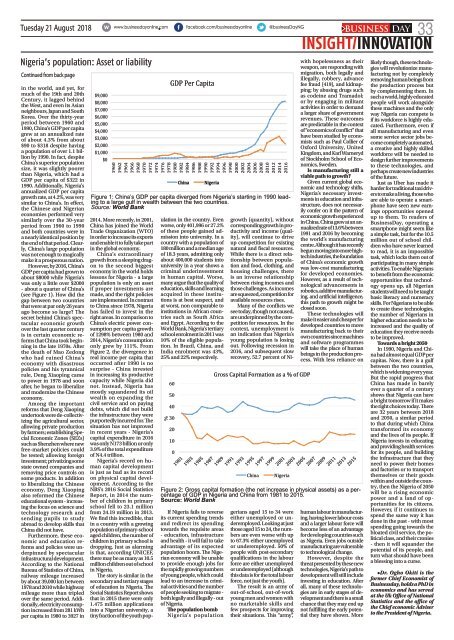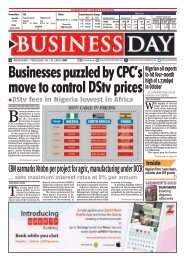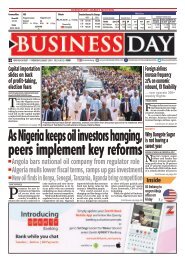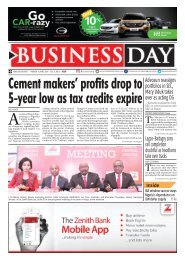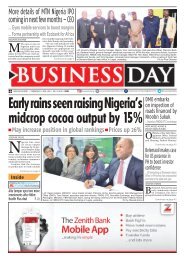BusinessDay 21 Aug 2018
You also want an ePaper? Increase the reach of your titles
YUMPU automatically turns print PDFs into web optimized ePapers that Google loves.
Tuesday <strong>21</strong> <strong>Aug</strong>ust <strong>2018</strong><br />
Nigeria’s population: Asset or liability<br />
Continued from back page<br />
in the world, and yet, for<br />
much of the 19th and 20th<br />
Century, it lagged behind<br />
the West, and even its Asian<br />
neighbours, Japan and South<br />
Korea. Over the thirty-year<br />
period between 1960 and<br />
1990, China’s GDP per capita<br />
grew at an annualized rate<br />
of about 4.3% from about<br />
$90 to $318 despite having<br />
a population of over 1.1 billion<br />
by 1990. In fact, despite<br />
China’s superior population<br />
size, it was slightly poorer<br />
than Nigeria, which had a<br />
GDP per capita of $322 in<br />
1990. Additionally, Nigeria’s<br />
annualized GDP per capita<br />
growth rate, at 4.2%, was very<br />
similar to China’s. In effect,<br />
the Chinese and Nigerian<br />
economies performed very<br />
similarly over the 30-year<br />
period from 1960 to 1990<br />
and both countries were in<br />
a nearly identical position by<br />
the end of that period. Clearly,<br />
China’s large population<br />
was not enough to magically<br />
make it a prosperous nation.<br />
However, by 2016, China’s<br />
GDP per capita had grown to<br />
about $8000 while Nigeria’s<br />
was only a little over $2000<br />
- about a quarter of China’s<br />
(see Figure 1). How did the<br />
gap between two countries<br />
that were at par only 26 years<br />
ago become so large? The<br />
secret behind China’s spectacular<br />
economic growth<br />
over the last quarter century<br />
is in certain economic reforms<br />
that China took beginning<br />
in the late 1970s. After<br />
the death of Mao Zedong<br />
who had ruined China’s<br />
economy with disastrous<br />
policies and his tyrannical<br />
rule, Deng Xiaoping came<br />
to power in 1978 and soon<br />
after, he began to liberalize<br />
and modernize the Chinese<br />
economy.<br />
Among the important<br />
reforms that Deng Xiaoping<br />
undertook were de-collectivizing<br />
the agricultural sector,<br />
allowing private production<br />
by farmers; establishing Special<br />
Economic Zones (SEZs)<br />
such as Shenzhen where new<br />
free-market policies could<br />
be tested; allowing foreign<br />
investment; privatizing some<br />
state owned companies and<br />
removing price controls on<br />
some products. In addition<br />
to liberalizing the Chinese<br />
economy, Deng Xiaoping<br />
also reformed the Chinese<br />
educational system - increasing<br />
the focus on science and<br />
technology research and<br />
sending pupils to study<br />
abroad to develop skills that<br />
China did not have.<br />
Furthermore, these economic<br />
and education reforms<br />
and policies were underpinned<br />
by spectacular<br />
infrastructural development.<br />
According to the National<br />
Bureau of Statistics of China,<br />
railway mileage increased<br />
by about 39,000 km between<br />
1978 and 2010 while highway<br />
mileage more than tripled<br />
over the same period. Additionally,<br />
electricity consumption<br />
increased from 281 kWh<br />
per capita in 1980 to 3927 in<br />
$9,000 <br />
$8,000 <br />
$7,000 <br />
$6,000 <br />
$5,000 <br />
$4,000 <br />
$3,000 <br />
$2,000 <br />
$1,000 <br />
$0 <br />
1960 <br />
1962 <br />
1964 <br />
1966 <br />
1968 <br />
1970 <br />
1972 <br />
1974 <br />
1976 <br />
1978 <br />
1980 <br />
1982 <br />
1984 <br />
1986 <br />
1988 <br />
1990 <br />
1992 <br />
1994 <br />
1996 <br />
1998 <br />
2000 <br />
2002 <br />
2004 <br />
2006 <br />
2008 <br />
2010 <br />
2012 <br />
2014 <br />
2016 <br />
Figure 1: China’s GDP per capita diverged from Nigeria’s starting in 1990 leading<br />
to a large gulf in wealth between the two countries.<br />
Source: World Bank<br />
GDP Per Capita <br />
China <br />
Nigeria <br />
2014. More recently, in 2001,<br />
China has joined the World<br />
Trade Organization (WTO)<br />
in order to increase its exports<br />
and enable it to fully take part<br />
in the global economy.<br />
China’s extraordinary<br />
growth from a sleeping dragon<br />
to the second biggest<br />
economy in the world holds<br />
lessons for Nigeria - a large<br />
population is only an asset<br />
if proper investments are<br />
made, and the right policies<br />
are implemented. In contrast<br />
to China since 1978, Nigeria<br />
has failed to invest in the<br />
right areas. In comparison to<br />
China’s electric power consumption<br />
per capita growth<br />
of 1298% between 1980 and<br />
2014, Nigeria’s consumption<br />
only grew by 111%. From<br />
Figure 2, the divergence in<br />
real income per capita that<br />
occurred after 1990 is no<br />
surprise - China invested<br />
in increasing its productive<br />
capacity while Nigeria did<br />
not. Instead, Nigeria has<br />
mostly squandered its oil<br />
wealth on expanding the<br />
civil service and on paying<br />
debts, which did not build<br />
the infrastructure they were<br />
purportedly incurred for. The<br />
situation has not improved<br />
in recent years - Nigeria’s<br />
capital expenditure in 2016<br />
was only N173 billion or only<br />
3.9% of the total expenditure<br />
of N4.4 trillion.<br />
Nigeria’s record on human<br />
capital development<br />
is just as bad as its record<br />
on physical capital development.<br />
According to the<br />
NBS’s 2016 Social Statistics<br />
Report, in 2014 the number<br />
of children in primary<br />
school fell to 23.1 million<br />
from 24.19 million in 2013.<br />
We find this incredible, that<br />
in a country with a growing<br />
population of primary-school<br />
aged children, the number of<br />
children in primary school is<br />
dropping. Just as alarming<br />
is that, according UNICEF,<br />
there may be as many as 10.5<br />
million children out of school<br />
in Nigeria.<br />
The story is similar in the<br />
secondary and tertiary stages<br />
of education in Nigeria. The<br />
Social Statistics Report shows<br />
that in 2015 there were only<br />
1.475 million applications<br />
into a Nigerian university, a<br />
tiny fraction of the youth population<br />
in the country. Even<br />
worse, only 401,996 or 27.2%<br />
of these people gained admission<br />
into university. In a<br />
country with a population of<br />
180 million and a median age<br />
of 18.3 years, admitting only<br />
about 400,000 students into<br />
university in a year shows a<br />
criminal underinvestment<br />
in human capital. Worse,<br />
many argue that the quality of<br />
education, skills and learning<br />
acquired in these institutions<br />
is at best suspect, and<br />
at worst, non comparable to<br />
institutions in African countries<br />
such as South Africa<br />
and Egypt. According to the<br />
World Bank, Nigeria’s tertiary<br />
school enrolment in 2011 was<br />
10% of the eligible population.<br />
In Brazil, China, and<br />
India enrolment was 43%,<br />
25% and 22% respectively.<br />
% <br />
60 <br />
50 <br />
40 <br />
30 <br />
20 <br />
10 <br />
0 <br />
1981 <br />
1983 <br />
Gross Capital Formation as a % of GDP <br />
1985 <br />
1987 <br />
1989 <br />
1991 <br />
1993 <br />
1995 <br />
China <br />
1997 <br />
1999 <br />
2001 <br />
Nigeria <br />
BUSINESS DAY 33<br />
INSIGHT/INNOVATION<br />
2003 <br />
2005 <br />
2007 <br />
2009 <br />
2011 <br />
2013 <br />
2015 <br />
Figure 2: Gross capital formation (the net increase in physical assets) as a percentage<br />
of GDP in Nigeria and China from 1981 to 2015.<br />
Source: World Bank<br />
If Nigeria fails to reverse<br />
its current spending trends<br />
and redirect its spending<br />
towards the requisite areas<br />
- education, infrastructure<br />
and health - it will fail to take<br />
advantage of its expected<br />
population boom. The Nigerian<br />
economy will be unable<br />
to provide enough jobs for<br />
the rapidly growing numbers<br />
of young people, which could<br />
lead to an increase in criminal<br />
activities and the number<br />
of people seeking to migrate -<br />
both legally and illegally - out<br />
of Nigeria.<br />
The population bomb<br />
Nigeria’s population<br />
gerians aged 15 to 34 were<br />
either unemployed or underemployed.<br />
Looking at just<br />
those aged 15 to 24, the numbers<br />
are even worse with up<br />
to 67.3% either unemployed<br />
or underemployed. 50% of<br />
people with post-secondary<br />
qualifications in the labour<br />
force are either unemployed<br />
or underemployed (although<br />
this data is for the total labour<br />
force, not just the youth).<br />
The result is an army of<br />
out-of-school, out-of-work<br />
young men and women with<br />
no marketable skills and<br />
few prospects for improving<br />
their situations. This “army”,<br />
growth (quantity), without<br />
corresponding growth in productivity<br />
and income (quality),<br />
will continue to drive<br />
up competition for existing<br />
natural and fiscal resources.<br />
While there is a direct relationship<br />
between population<br />
and food, clothing, and<br />
housing challenges, there<br />
is an inverse relationship<br />
between rising incomes and<br />
those challenges. As incomes<br />
are squeezed, competition for<br />
available resources rises.<br />
Many of the conflicts we<br />
see today, though not caused,<br />
are underpinned by the competition<br />
for resources. In the<br />
context, unemployment is<br />
an indication that Nigeria’s<br />
young population is losing<br />
out. Following recession in<br />
2016, and subsequent slow<br />
recovery, 52.7 percent of Niwith<br />
hopelessness as their<br />
weapon, are responding with<br />
migration, both legally and<br />
illegally, robbery, advance<br />
fee fraud (419), and kidnapping;<br />
by abusing drugs such<br />
as codeine and Tramadol;<br />
or by engaging in militant<br />
activities in order to demand<br />
a larger share of government<br />
revenues. These outcomes<br />
are predictable in the context<br />
of “economics of conflict” that<br />
have been studied by economists<br />
such as Paul Collier of<br />
Oxford University, United<br />
Kingdom, and Karl Warneryd<br />
of Stockholm School of Economics,<br />
Sweden.<br />
Is manufacturing still a<br />
viable path to growth?<br />
Given current global economic<br />
and technology shifts,<br />
Nigeria’s necessary investments<br />
in education and infrastructure,<br />
does not necessarily<br />
confer on it the pattern of<br />
economic growth experienced<br />
in China. China grew at an annualized<br />
rate of 13.6% between<br />
1991 and 2016 by becoming<br />
the world’s manufacturing<br />
centre. Although it has recently<br />
begun moving into more hightech<br />
industries, the foundation<br />
of China’s economic growth<br />
was low-cost manufacturing<br />
for developed economies.<br />
However, as a result of technological<br />
advancements in<br />
robotics, additive manufacturing,<br />
and artificial intelligence,<br />
this path to growth might be<br />
closed soon.<br />
These technologies will<br />
make it easier and cheaper for<br />
developed countries to move<br />
manufacturing back to their<br />
own countries since machines<br />
and software programmes<br />
will take the place of human<br />
beings in the production process.<br />
With less reliance on<br />
human labour in manufacturing,<br />
having lower labour costs<br />
and a larger labour force will<br />
become less of an advantage<br />
for developing countries such<br />
as Nigeria. Even jobs outside<br />
manufacturing are vulnerable<br />
to technological change.<br />
However, despite the<br />
threat presented by these new<br />
technologies, Nigeria’s path to<br />
development will still include<br />
investing in education. After<br />
all, many of these technologies<br />
are in early stages of development<br />
and there is a small<br />
chance that they may end up<br />
not fulfilling the early potential<br />
they have shown. More<br />
likely though, these technologies<br />
will revolutionize manufacturing<br />
not by completely<br />
removing human beings from<br />
the production process but<br />
by complementing them. In<br />
such a world, highly educated<br />
people will work alongside<br />
these machines and the only<br />
way Nigeria can compete is<br />
if its workforce is highly educated.<br />
Furthermore, even if<br />
all manufacturing and even<br />
some service sector jobs become<br />
completely automated,<br />
a creative and highly skilled<br />
workforce will be needed to<br />
design further improvements<br />
to these technologies, and<br />
perhaps create new industries<br />
of the future.<br />
Just as Uber has made it<br />
harder for traditional taxi drivers<br />
to make a living, those who<br />
are able to operate a smartphone<br />
have seen new earnings<br />
opportunities opened<br />
up to them. To readers of<br />
<strong>BusinessDay</strong>, operating a<br />
smartphone might seem like<br />
a simple task, but for the 10.5<br />
million out of school children<br />
who have never learned<br />
to read, it is an impossible<br />
task, which locks them out of<br />
participating in many simple<br />
activities. To enable Nigerians<br />
to benefit from the economic<br />
opportunities that technology<br />
opens up, all Nigerian<br />
students will need to be taught<br />
basic literacy and numeracy<br />
skills. For Nigerians to be able<br />
to create these technologies,<br />
the number of Nigerians in<br />
higher education needs to be<br />
increased and the quality of<br />
education they receive needs<br />
to be improved.<br />
Towards a bright 2050<br />
In 1990, Nigeria and China<br />
had almost equal GDP per<br />
capitas. Now, there is a gulf<br />
between the two countries,<br />
which is widening every year.<br />
But the rapid progress that<br />
China has made in barely<br />
over a quarter of a century<br />
shows that Nigeria can have<br />
a bright tomorrow if it makes<br />
the right choices today. There<br />
are 32 years between <strong>2018</strong><br />
and 2050, a similar period<br />
to that during which China<br />
transformed its economy<br />
and the lives of its people. If<br />
Nigeria invests in educating<br />
and providing health services<br />
for its people, and building<br />
the infrastructure that they<br />
need to power their homes<br />
and factories or to transport<br />
themselves or their goods<br />
within and outside the country,<br />
then the Nigeria of 2050<br />
will be a rising economic<br />
power and a land of opportunities<br />
for its citizens.<br />
However, if it continues to<br />
spend the same way it has<br />
done in the past - with most<br />
spending going towards the<br />
bloated civil service, the political<br />
class, and their cronies<br />
- then it will squander the<br />
potential of its people, and<br />
turn what should have been<br />
a blessing into a curse.<br />
•Dr. Ogho Okiti is the<br />
former Chief Economist of<br />
Businessday, holds a PhD in<br />
economics and has served<br />
at the Uk Office of National<br />
Statistics and the office of<br />
the Chief economic Adviser<br />
to the President of Nigeria.


